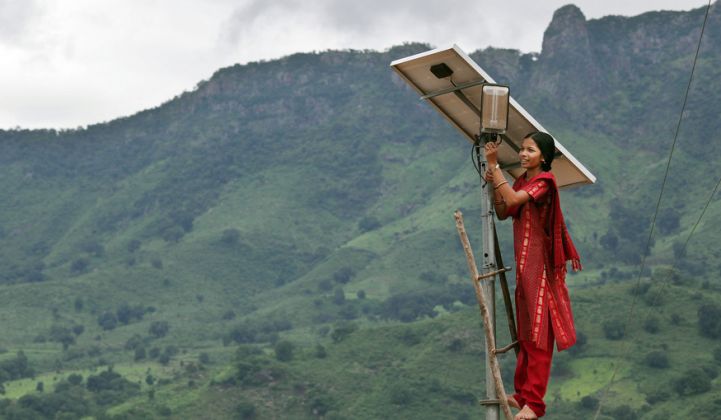Family foundations, family offices and other non-traditional investors haven’t branched out much over the years when it comes to philanthropy and grant-making. But that may be changing.
With a host of foundations exploring new innovative approaches to grant-making and program-related investments (PRIs), these sleepy institutions may be poised to unlock cleantech in frontier markets.
Just this week, the White House held an energy access event that served as a platform to announce investments. A few of these investments stick out as an innovative approach that others in this space may be exploring. The David and Lucile Packard Foundation’s use of philanthropic tools to support $15 million in projects is an example of the potential for impact-driven investors to unlock much greater amounts of capital over time to combat energy poverty and climate change.
As the Packard Foundation explained as part of the White House briefing, "These investments in distributed solar through Simpa Networks, SunFunder, and Off-Grid Electric assist in providing clean electricity for low-income communities and constitute a portion of a larger commitment to increase climate and energy investments. Ultimately, these investments address both the urgency of mitigating climate change and achieving life-changing development outcomes."
The Packard Foundation’s innovative use of program-related investments (PRIs), using a carve-out from the foundation’s endowment to make programmatically driven investments with some financial returns, has provided much-needed debt that beyond-the-grid enterprises have been demanding for years.
According to Susan Phinney Silver, who directs Packard’s PRI program, the organization is "focused on growing promising enterprises and business models that can create meaningful impact for clean energy access markets." Early-stage companies were selected that otherwise would not qualify for debt in a commercial marketplace, and Packard’s PRI financing helps prove out risk concerns so that the companies might qualify in the future for commercial loans and other mainstream private capital.
Investing in clean energy solutions is something other family foundations are considering, and it could play a pivotal role in developing and de-risking the use of syndicated loan structures through PRIs to meet the growth capital needs of beyond-the-grid enterprises.
The use of PRIs to unlock debt for beyond-the-grid enterprises shows how family foundations can move out of a role dominated by less-catalytic contributions such as technical assistance grants and instead move into catalytic investments investing directly into enterprises.
But if foundations do not have PRI facilities, all is not lost. Using foundation grants to take the first-loss position in a debt structure can prove equally valuable for unlocking debt by de-risking the lending opportunity for private lenders and commercial banks to come onboard.
That’s important because family foundations can better utilize PRIs and first-loss positions to unlock the tremendous growth capital demands of the beyond the grid industry. One of the more easily rectifiable problems facing the industry is the shortage of debt capital, resolved by encouraging lending institutions to work together in syndicate to spread risk across multiple balance sheets.
Yet, this seemingly obvious solution is stuck as many lenders seek to monopolize deals exclusively while holding high-risk perceptions of the market. However, deals like those the Packard Foundation announced today show the power of collaboration with other lenders -- leveraging their flexible investment capital with catalytic grants to encourage the private sector and other DFIs to come to the table.
Indeed, there are several family foundations, family offices and other non-traditional investors currently exploring this space. If even a handful of these institutions set aside $40 million to $50 million collectively for PRIs and first loss, it could unlock growth capital for beyond-the-grid enterprises that could propel this market forward for decades to come.
These lessons and others will be captured in a working paper on best practices for investing beyond the grid, set for release later this year. What’s clear is that beyond-the-grid organizations require more longitudinal data on lending performance with a focus on consumer financing through pay-as-you-go business models. The vision pertains to how larger loan sizes perform across nuanced business models over time with emphasis on consumer financing tenors.
Creating a lending fund with an intentionally revised investment thesis that allows for higher-risk loans would serve as a breakthrough innovation, decreasing future lending error rates and increasing portfolio performance for future deals -- a pinnacle data set for private lenders to get into the game. Family foundations using PRIs and first loss as key tools may be the ticket to graduate lenders from discussions and catalyze capital for beyond-the-grid enterprises.
The Packard Foundation, along with other collaborators, has demonstrated today that financial innovation can come from unlikely places. Now it’s important that this demonstration be replicated by the dozens of other foundations that could collectively move this market and end energy poverty beyond the grid once and for all.
***
Daniel Tomlinson is an access-to-energy entrepreneur and 2012 Echoing Green Fellow. In 2009, he co-founded Frontier Markets, a distribution company whose aim is to build scalable clean-energy access to last-mile markets in India.



